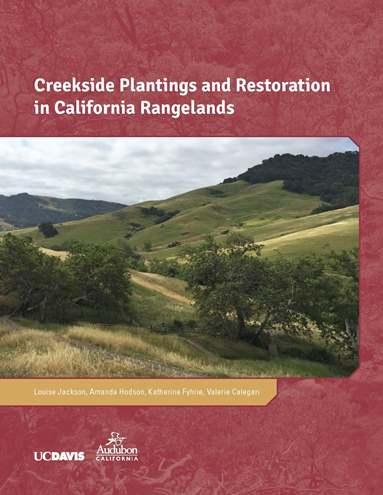Riparian Restoration in California Rangelands

Ranches that rim California’s Central Valley are important in providing habitat for many animal species that were once wide-ranging, e.g. freshwater fish, wintering birds and waterfowl, invertebrates, and mammals. Rangeland riparian corridors, though often seasonally ephemeral, provide ecological connectivity with the large river systems in the Central Valley. Riparian restoration requires a significant commitment from the landowner or land manager. Riparian corridors on ranches in the Central Valley typically occur on marginal soils without irrigation, and on rocky or steep slopes. These settings are particularly challenging for habitat restoration.
Planning successful riparian habitat restoration practices on California ranches was the focus of a NRCS CIG project in 2012 to 2105. A 90-page booklet has been recently published using funds from the grant, which is entitled ‘Creekside Planting and Restoration in California Rangelands’.
To download a high resolution version of the booklet click here CreeksidePlantings_hi
To download a low resolution version of the booklet click here CreeksidePlantings_lo
An in-depth literature review compiled information from numerous relevant publications on restoration of upland riparian corridors. This is chapter 1 of the booklet and the title is ‘Habitat Restoration Practices for California Rangeland Riparian Corridors’. Topics include: planning strategies, technical aspects, and evaluation of success and failure of riparian restoration in California rangelands.
Three chapters then describe riparian restoration practices on three California Central Valley ranches: the Audubon Bobcat Ranch, Three Creeks Ranch, and Doty Ravine Preserve. At Bobcat Ranch, a two-year study of a habitat enhancement project took place with 280 restoration plantings along a stream corridor, to determine factors most conducive to establishment of different plant species. The descriptions of riparian restoration on the two other ranches were based on site visits and interviews with the rancher/land manager.
A worksheet for ranchers and landowners is the last chapter of the 90-page restoration booklet, entitled ‘Riparian Habitat Restoration Planning Worksheet for California Rangelands’.It is intended to help landowners and land managers with decisions about installing restoration projects that establish native plant species along creeks in California rangelands.